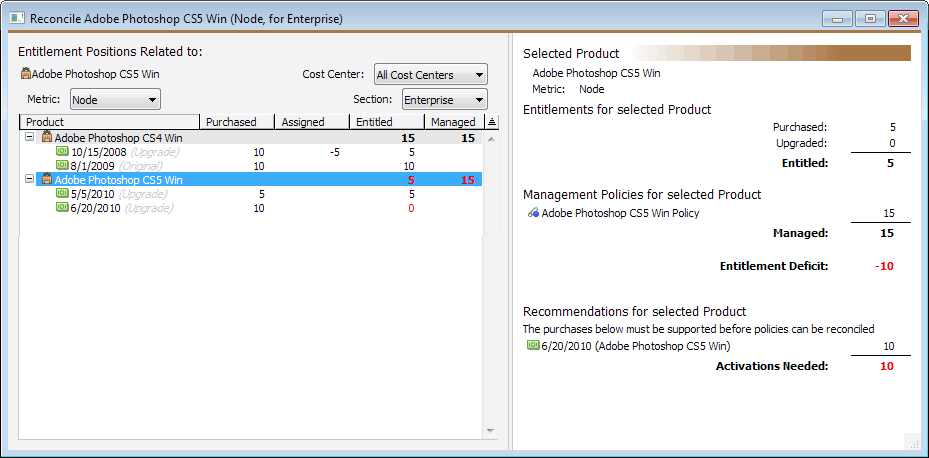Reconcile Wizard (single product)
After Purchase records have been entered, KeyConfigure will compute the effective entitlement totals for each software product, while carefully accounting for license expirations due to upgrades, subscription terms, etc. The Reconcile item from the Tasks menu or a right-click on white space in the Products window bring up the global Product Reconciliation window where you can see the current entitlement and management status of all products for which purchase records have been entered. When you right-click a specific Purchase, Product, or Policy, and select Reconcile... (note this option only shows for Manage Policies and Products with an Install count) a Reconcile Wizard specific to a single product is displayed showing details such as how entitlements from a specific purchase may have been Assigned to support an upgrade, etc. In order to understand the basic display on the left hand side of this window, you should first read and understand the Product Reconciliation documentation, which has a detailed explanation of the values in each column of the list.
Distinct Metrics
It is important to note that the same Product might be purchased with rights and conditions from more than one license model, i.e. "Metric". Entitlements under each metric are totaled separately and Policies which manage distinct metrics for the same product must be treated separately. Hence, only one metric is considered at a time. You can see the information for another metric by changing the selection in the Metric drop-down. If you opened this window by right-clicking a purchase or policy, then the metric for that purchase or policy will be the initial selection.
Products Displayed
The product you are reconciling is shown at the top of the window, outside of the list. This is the product you right-clicked, or the product associated with the purchase or policy you right-clicked. The list of products on the left includes this product as well as any “related” products. This essentially means products which may be upgraded to this product, or products which this product can be upgraded to. In order to determine upgrade paths, the product database is consulted, since each product has a field for defining the immediate predecessor, but the purchase database is also consulted, since any upgrade purchase can have a list of products from which the upgrade can happen.
Balance Sheet (Right hand side)
The right hand side of the Reconcile Window shows additional information about whatever is selected in the list on the Left Hand side. This information is too verbose to display in the list on the left, but will help you understand how your entitlements compare to your management configuration. This window will also help actively reconcile discrepancies. The information on the right is quite different depending on whether a Product or a Purchase is selected on the left.

With a Product selected, the right hand side displays information about the Entitlements for the product and the Management Policies for the product. The Entitlements section shows a summary of the number of Entitlements which were purchased, how many have subsequently been upgraded, and how many are currently entitled. This section does not list the individual purchases, since they are shown in detail on the left hand side. The Management section does list the applicable Policies, since they do not appear on the left hand side. If the Entitlements do not match the Management Policies, there will be a third section showing Recommendations for the select Product. This section describes ways in which the Product might be Reconciled. In the screenshot above, one of the purchases for Photoshop CS5 Win needs support. Once it has support the product will be fully reconciled. The Reconcile Window will help find support for that purchase, but not while the product is selected. Instead you must select the purchase which needs support, which will change what is displayed on the right hand side.
With a Purchase selected, the right hand side will potentially show four sections. The first two are always displayed - the number of Entitlements purchased, and the Support for the purchase. For an Original purchase you will see an indication that support comes from that exact purchase - no prior purchases are needed for support. The third section, which only appears when relevant, will show Upgrade Assignments. This section is only displayed when the selected purchase has had entitlements allocated towards a later purchase. Finally, just like when a Product was selected, there may be a section describing a discrepancy between the number of purchased entitlements and the number of activated entitlements. In the screenshot above you see that 10 entitlements were purchased, but because this purchase is an Upgrade, it needs support from prior purchases, and it does not currently have any support.
Again we see a list of Recommendations, but this time if one is selected we can click the “Apply” button which will actually create allocations and give this purchase the support it requires. In this case there are two obvious ways in which this purchase can be supported. If you select a recommendation and click Apply, the action will take place immediately without requiring a save in any detail window. The Reconcile Window will update to reflect the change you have made - often the Recommendations section will go away since the change may have been enough to remedy the situation.
There are many possible states which can be shown in the Reconcile Window, and many Recommendations available to help create a consistent configuration. Certain states may require a manual change if there is no change which is obviously an appropriate one. It would be very hard to describe every possible state in the is document, but with a basic understanding of this window together with the information presented in the window, each state should be easily understandable.